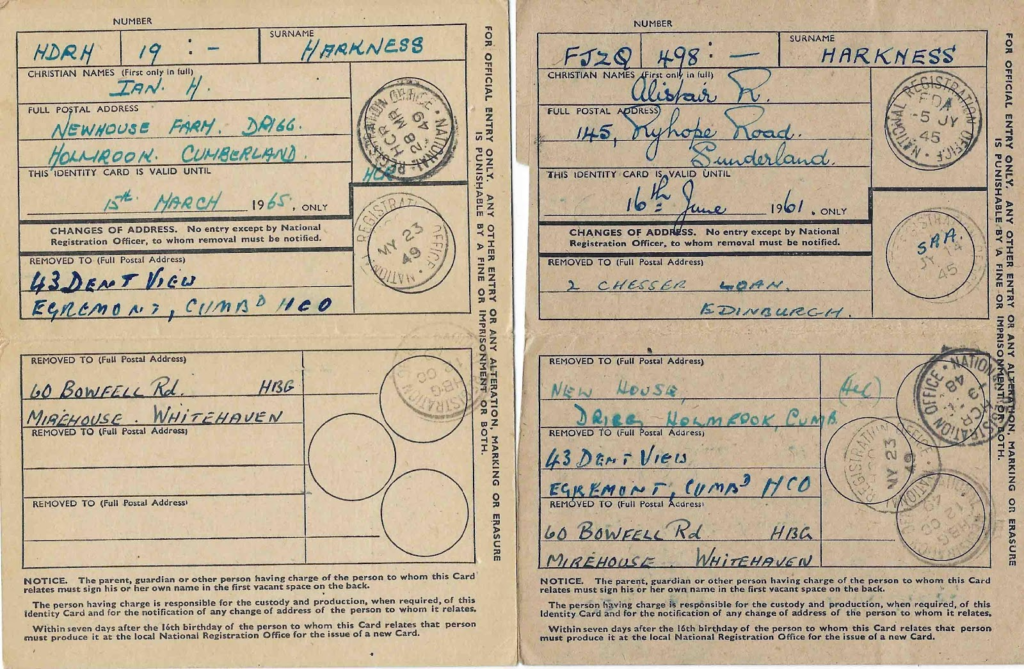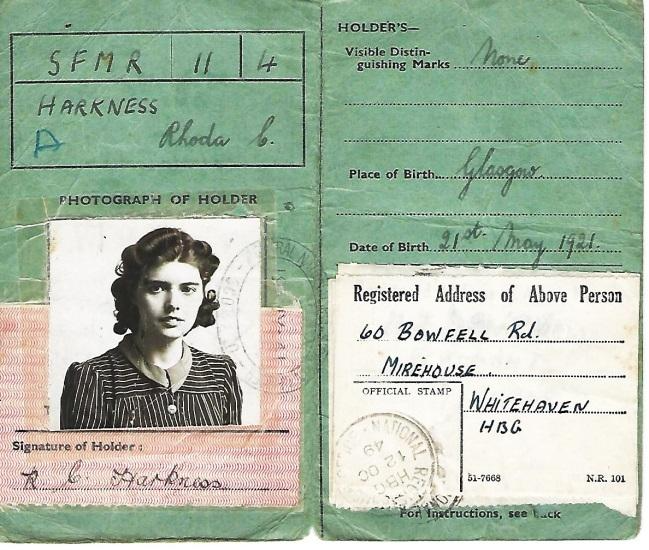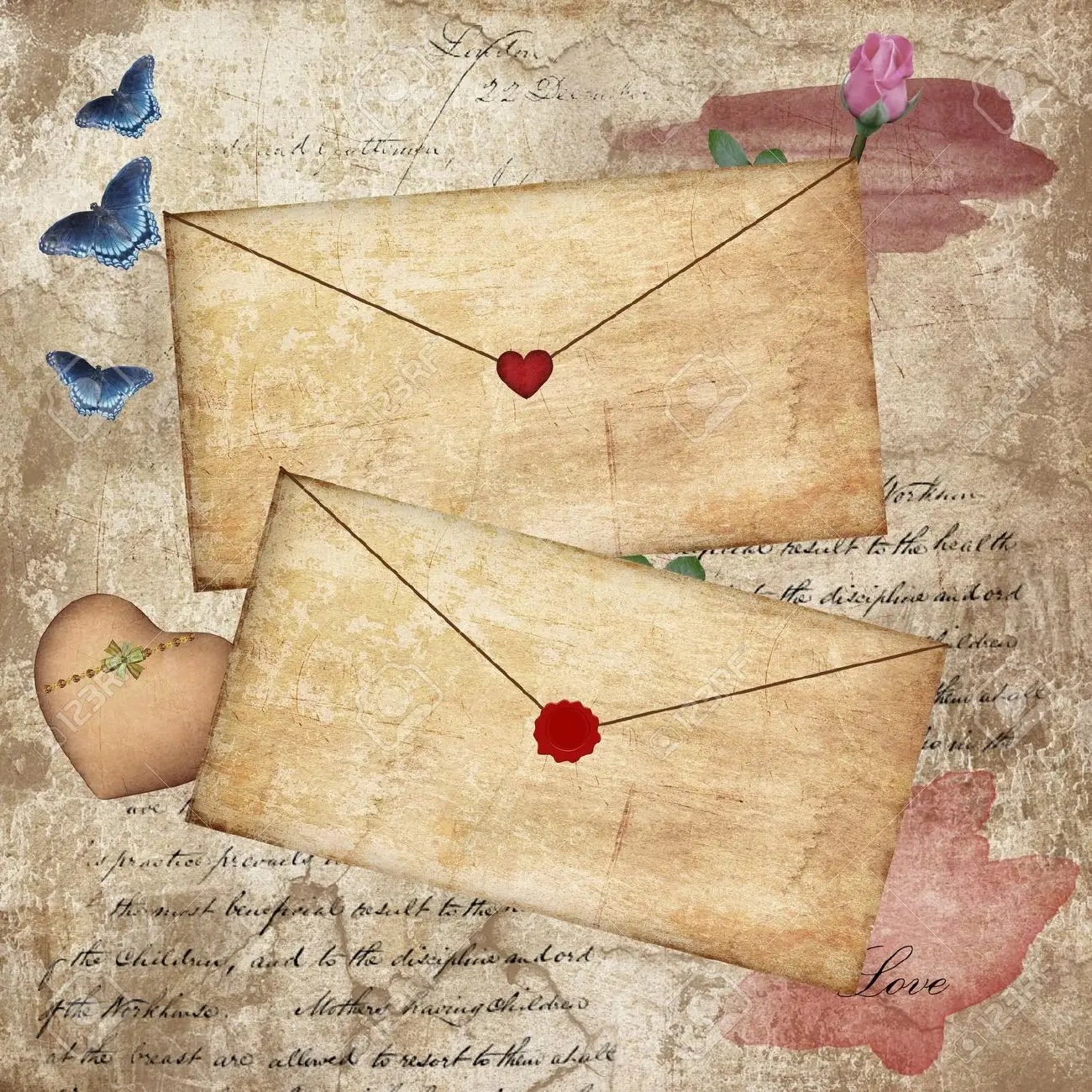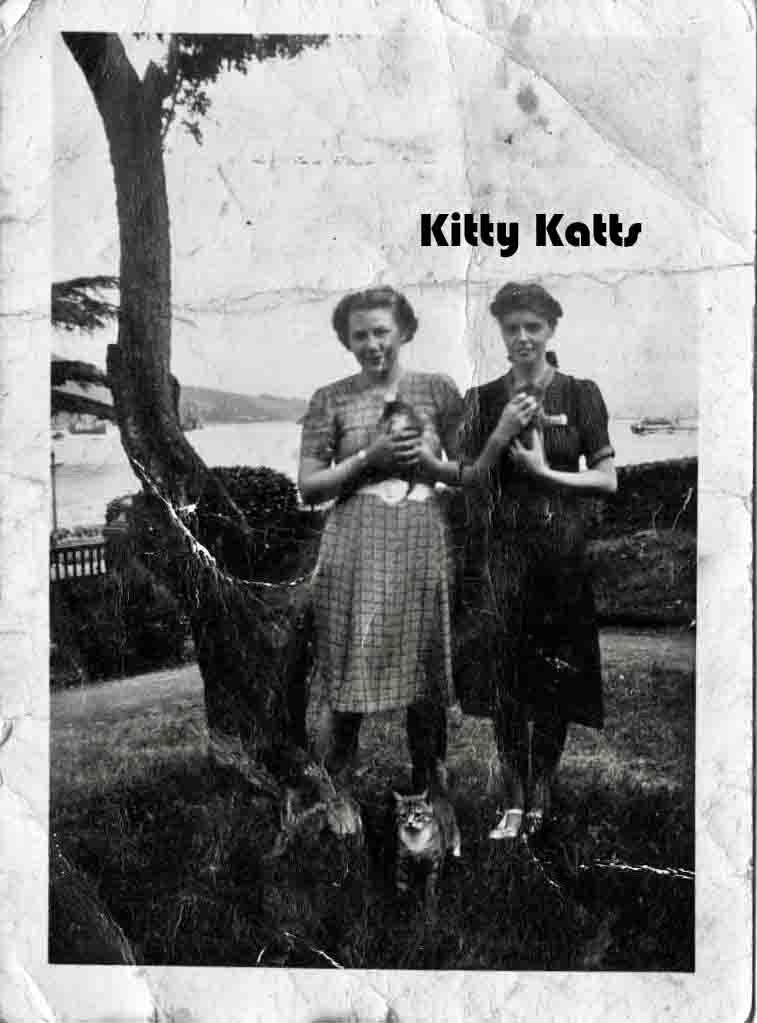We have initially focused on my father’s work and naval experiences before, during, and after the Second World War. Now, it makes sense to carry on in the same vein in this section; we will look at another type of official document, our National Identity Cards. These can often provide useful information, such as addresses and dates.
My Parents’ Identity Cards
To focus on specifics, let’s look at my mother’s National Identity Card above. The address is given as 60 Bowfell Road, Mirehouse, Whitehaven (Cumberland, England). This was stamped 12 October 1949 some months after my birth at Newhouse Farm, Drigg, Holmrook, Cumberland, England. Of course, this totally contradicts my father’s typewritten CV (based on his hastily and ‘vaguely’ written handwritten CV).

My father’s ‘National Registration’ card of the same date is also of interest. Here, his various ‘addresses’ were placed one on top of the other. In other words, the previous address of 43 Dent View Egremont, which is pasted beneath the Bowfell Road address, is only lightly visible.
So in the future, if I start to lose track of the many addresses where my parents lived, I could always try and ‘steam’ the various inserts away from each other – much like one steams a stamp from an envelope. Given that the address and the date are provided, this would be advantageous. But I won’t do this for the time being, as I now have a fairly good overview of their life during and immediately after the war.
Ian and Alistair’s

This shows two Identity Cards I have scanned together. Regarding Ian (ME), there is nothing new here. But regarding my elder brother, Alistair, there is something new. His identity card shows that he was a resident of 145 Ryhope Road, Sunderland, England, on July 5, 1945 (some three weeks after his birth). However, by July 14, he was registered at 2 Chesser Loan in Edinburgh.
Moreover, none of the other ID cards of the family show anyone registered as living in Sunderland. In other words, this seems to suggest that my mother preferred to give birth ‘at home’, and that my father was nearby. She didn’t want to give birth to her children ‘on her own’. Whether she gave birth at ‘home’ or in a hospital is unclear – but the evidence seems to suggest that she gave birth at home.
One thing is clear, however, she ‘moved house’ to be near my father when she gave birth to the first four sons (including ME). I don’t think my younger brother Gavin was ‘born at home’; otherwise, this is something I would have remembered. But at this point in time, my parents were living together on a permanent basis (regrettably one might say).
My Father Abroad
My father was sometimes shipped off abroad for short periods due to his job. One example was when he worked for James Scott in London when we lived in Billericay, Essex. I can recall that him leaving felt like ‘a holiday’. It was not so much because my father was such ‘a tyrant’; it was more because of the tensions between my parents. Not least, the ‘boss and judge’; my mother, had given the role of ‘executioner’ to my father.
My father worked in Sunderland for some months, or perhaps even a year or more. The dates are unclear here, as there is little official documentation. However, the letters written between my father and mother during the war provide ample evidence that he worked in Sunderland for a considerable time. At a rough guess, I would say he worked in Sunderland during 1944 and 1945. On the other hand, my mother was still living in Edinburgh, with her two baby sons, Sandy and Stuart.
When my father worked in Dunoon (1940-1943), he was able to visit my mother in Edinburgh. She also gave birth to Alexander and Stuart in Dunoon. But it seems my father’s permission to travel was limited when he was stationed in Sunderland. This will be referred to in “Letter 18” of the “Sunderland Letters” (see “Appendix III: List of Wartime Love Letters”).4
The Sunderland Letters
The “Sunderland Letters’ provide various pieces of interesting information. All the letters written during the six years during and after the war often broach the subject of ‘living together like man and wife – so that my father can shoulder the responsibility of fatherhood’. But their ‘moving together’ always seems to be delayed for one reason or another. It seems that it is only when my mother is about to give birth that he manages to ‘get his act together’. But this is something which I can discuss in more detail under the section on “Swalk”,5 that is, the wartime letters written by my parents.
One of the reasons why my mother wanted to move to Sunderland was that my father was restricted from travelling more than 20 miles from his base; this was due to wartime regulations. Thus, it was difficult for him to visit her in Edinburgh.
One might say, cynically, that this suited him; as by 1944 he was perhaps ‘recovered’ from his initial infatuation with my mother. Suddenly, he had to deal with her difficult and demanding nature. Of course, there is the sheer practicality of the situation; I don’t think my father could afford to pay for a mortgage in Edinburgh, and also pay rent for a house in Sunderland. If nothing else, I think my father was on the whole a practical man.
What did my father do in Sunderland?
I don’t know – as there is no documentation. However, I think his responsibilities had been increased. He mentions that he was in charge of 35 men (“Letter 7”). I think there is no doubt that my father was a ‘leader of men’, at least in a small way. Later, when he worked for the Atomic Energy as chief draughtsman, he would be in charge of many others.
Ironically, I did not inherit any of these ‘leadership qualities’ due to the fact that I opposed my ‘dictatorial’ parents, my dictatorial schools, and other institutions. Ironically, as of 2023, we can see developments where people oppose dictatorial systems; for example, the green and red movements. Unfortunately, there is also a tendency in the present day for people to follow populists, such as the ‘anti-democratic’ former US president, Trump.
For the time being, it seems this is all we can glean from the National Registration Identity Cards (but also ‘corrected’ with information from the ‘love letters’).
4 The letters are discussed in a separate section here (see “Table of Contents”). Because of the sheer volume of the letters, they will not be included in their entirety here, but posted/published in a separate volume called “SWALK.”
5 “Swalk” stands for “Sealed with a loving kiss” – which was often written on the back of envelopes of ‘love letters’, and letters between married couples.




One Reply to “My family’s National Registration Identity Cards”